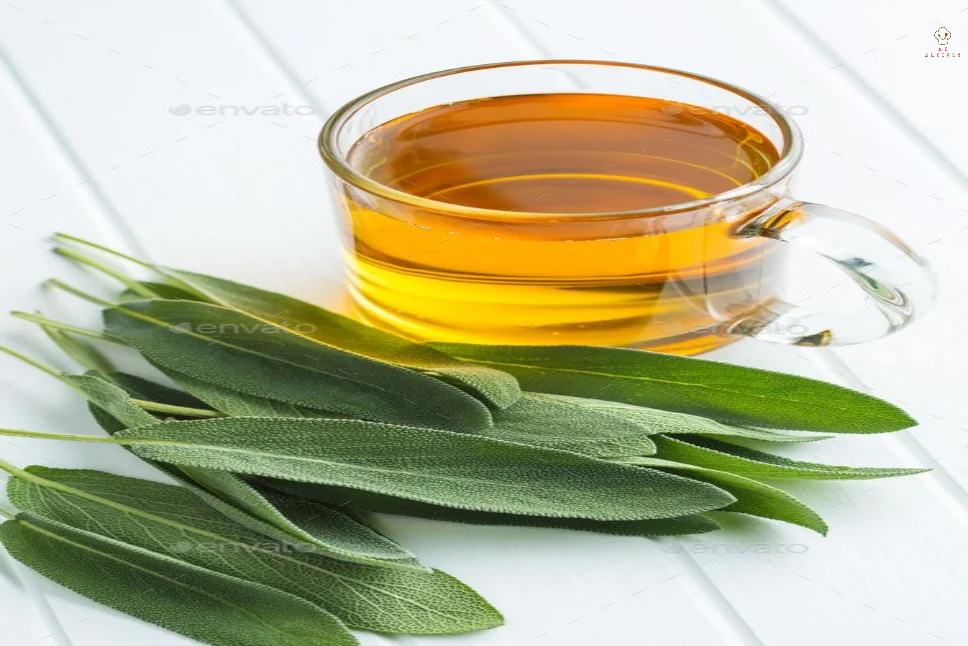Sage Tea: Baba tea is a significant aspect of Eastern hospitality and society. This kind of tea is well-liked because of its distinct flavor and scent.

Would you drink this Sage Tea?
Sage tea is unique due to its ingredients and preparation techniques. This article will cover the components of sage tea and how it is made.
Sage tea is a versatile herbal infusion made by steeping sage leaves, often enhanced with complementary flavors for a unique twist.
Ingredients of Sage Tea
The following ingredients are required to make Baba tea:
- Water: The main ingredient for tea.
- Tea leaves: Good quality tea leaves enhance the flavor of sage tea.
- Milk: Condensed and fresh milk makes tea tastier.
- Sugar: As per taste.
- Cardamom: To enhance aroma and taste.
- Cinnamon: Gives a unique flavor to tea.
- Ginger: For warmth and fragrance.
What is sage used to treat?
Sage species, traditionally used in traditional medicine, have been found to relieve pain, protect against infections, inflammation, and oxidative stress, and may be considered for therapeutic development.
Blackberry sage tea combines the earthy, aromatic qualities of sage with the sweet and tangy taste of blackberries, offering a refreshing drink rich in antioxidants. Similarly, pineapple sage tea blends sage with the tropical sweetness of pineapple, providing a fruity and calming experience.

What are the side effects of sage tea?
Although sage tea is usually well tolerated, too much of it might cause negative consequences like: The mouth and throat Irritation: Some people could have moderate tongue and throat irritation. Discomfortable Stomach: Drinking a much of sage tea can cause an upset stomach.
What does sage do for a woman?
Sage may be able to address chemical imbalances in the brain that lead to cognitive and memory issues. Additionally, it may alter the body’s usage of sugar and insulin. Sage is frequently used to treat menopausal symptoms, excessive cholesterol, and memory and cognitive abilities.
Can I drink sage every day?
Although sage tea is regarded as safe to consume, it shouldn’t be consumed in excess or at high dosages every day. This is because excessive amounts of sage (or more than 3–7 grams of thujone day) might cause: Heart problems. seizures.
Is sage tea safe for kidneys?
Sage’s diuretic and purifying qualities make it an excellent tool for kidney cleansing as well. In addition to promoting detoxification by aiding in the removal of fluids, sage consumption can help reduce edema, inflammation, and swelling.
Method of Preparation for Sage Tea
- The process of making baba tea is simple but time-consuming to bring out the full flavor:
- Put two cups of water in a pan and heat it on medium heat.
- Add a spoonful of tea leaves to water and boil it well.
- Add a pinch of cardamom powder, a small piece of cinnamon, and some finely chopped ginger to the boiling water.
- When it starts to smell, add half a cup of milk and mix.
- Finally, add sugar as per taste and let the tea boil once more.
Benefits of sage tea
- Baba tea is not only great in taste but also has health benefits:
- Cardamom and cinnamon improve digestion.
- Ginger relieves sore throat and boosts immunity.
- Hot tea helps to relieve fatigue.

Does sage tea burn fat?
Although sage leaves have some health benefits, like enhancing digestion, there isn’t any concrete scientific proof that they help reduce belly fat. To effectively manage weight, it’s critical to eat a balanced diet and exercise frequently.
Who should not drink sage?
Common sage contains thujone, which may cause seizures in animals and humans, so taking sage supplements without consulting a doctor may not be beneficial.
For a traditional and earthy flavor, white sage tea is a soothing option, often associated with cleansing rituals. Blueberry sage tea introduces the sweetness of blueberries to sage’s robust profile, creating a nutrient-packed drink. Clary sage tea, known for its aromatic and slightly floral flavor, is often praised for its potential stress-relieving properties.
What is the main use of sage?
Sage, a spice and therapeutic remedy, has been used in Chinese, Native American, and ancient Greek and Roman medicine for treating conditions like diabetes, cholesterol, memory loss, and sore throats.
Moving beyond beverages, lemon sage tea tree shampoo combines lemon, sage, and tea tree oil for a refreshing and invigorating hair care solution. Whether for drinking or personal care, sage’s adaptability makes it a staple in herbal remedies and wellness routines.
Can I drink sage tea before bed?
Since sage tea doesn’t contain caffeine by nature, you can drink it whenever you want without interfering with your sleep schedule. Because of its calming and warming qualities, drinking sage tea before bed can help you sleep better.

How to use sage tea?
Boil water, ginger, and sage, cover, simmer for 15 minutes, then strain into a mug. Enjoy with lemon and honey, sage is not recommended for pregnant or breastfeeding women.
In Brief
Baba tea has special importance due to its aroma, taste, and unique preparation. Be it a morning start or an evening party, a cup of baba tea can always brighten your day. If you haven’t tried baba tea yet, try this recipe today and introduce your loved ones to this special taste.





[…] this article, we will examine the ingredients of dark roasted coffee, its brewing tips, and its health […]